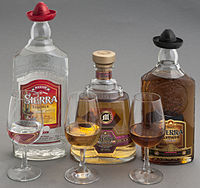
Photo from wikipedia
Production of sugarcane (Saccharum officinarum L.) is one of the most important agricultural, business, and labor activities at Jalisco, Mexico. Currently, in Mexico, Jalisco and Veracruz produce 28.3 million tons… Click to show full abstract
Production of sugarcane (Saccharum officinarum L.) is one of the most important agricultural, business, and labor activities at Jalisco, Mexico. Currently, in Mexico, Jalisco and Veracruz produce 28.3 million tons of cane for production of sugar, paper, livestock feed, and soil bioremediation (Pernalete et al. 2008, AguilarRivera 2011, García-Torres et al. 2011, SIAP 2019). Considering the significant production of sugarcane, it is common to report insect pests affecting yield and quality. For example, weevils of the genus Sphenophorus (Coleoptera: Curculionidae) affect yield when feeding on the stalk of the sugarcane plant (BarretoTriana et al. 2014). In the genus, Sphenophorus incurrens Gyllenhal (Coleoptera: Curculionidae) is an emerging pest of sugarcane cultivation at Oaxaca, San Luis, Puebla, Michoacán, Morelos, and Veracruz (Van Zwaluwenburg 1950, Vaurie 1954, Romero et al. 1996, Segura-León et al. 2013, Pérez et al. 2014, Ruiz-Montiel et al. 2015, Domínguez-Monge et al. 2017). In the sugarcane-producing area of the State of Jalisco, from 2016 to 2020, damage to the cane crop was reported, possibly by weevil larvae and adults. To generate basic information for management of the insect pest, the objective of this work was to report S. incurrens in cultivation of sugarcane in the State of Jalisco, Mexico. In January and March 2020, sugarcane plants with symptoms of wilting, decay, and rot in stalks were observed at the location of “El Chante” (19° 43'44”N, 104° 11'01” W; 886 mm) and "Ayuquila" (19° 49'28 "N, 104° 14'32" W; 860 mm; Fig. 1). Plants with symptoms were cut at the base, and the stalk was sectioned into parts (10 to 15 cm) to extract S. incurrens larvae and adults. The insects were put individually with pieces of cane in transparent 40-mL plastic cups. The samples were labeled and transferred to the Biotechnology Laboratory of the University Center of
Journal Title: Southwestern Entomologist
Year Published: 2023
Link to full text (if available)
Share on Social Media: Sign Up to like & get
recommendations!